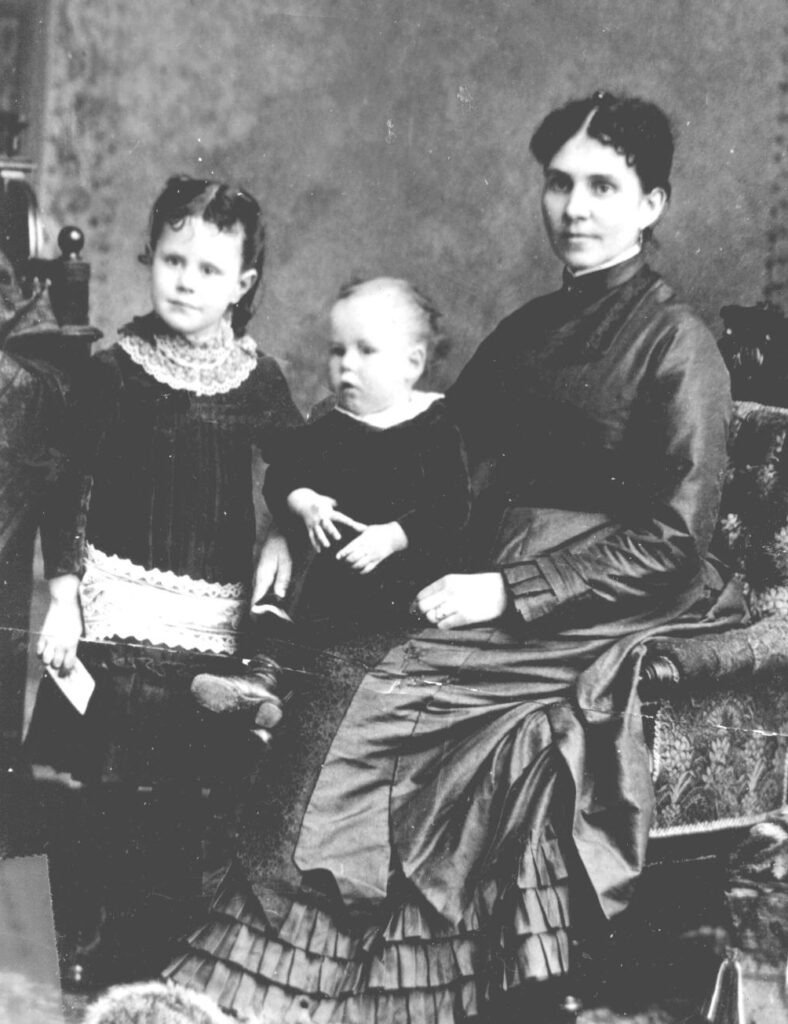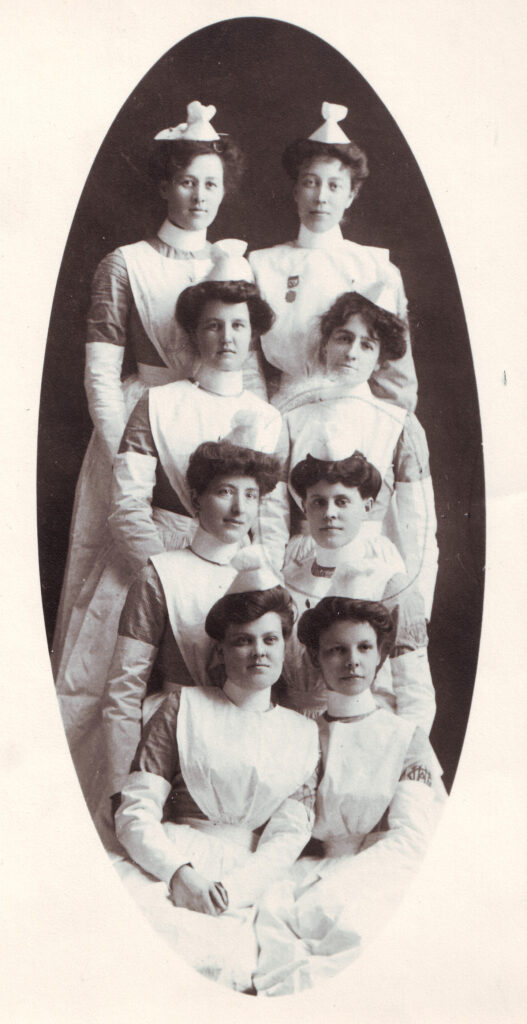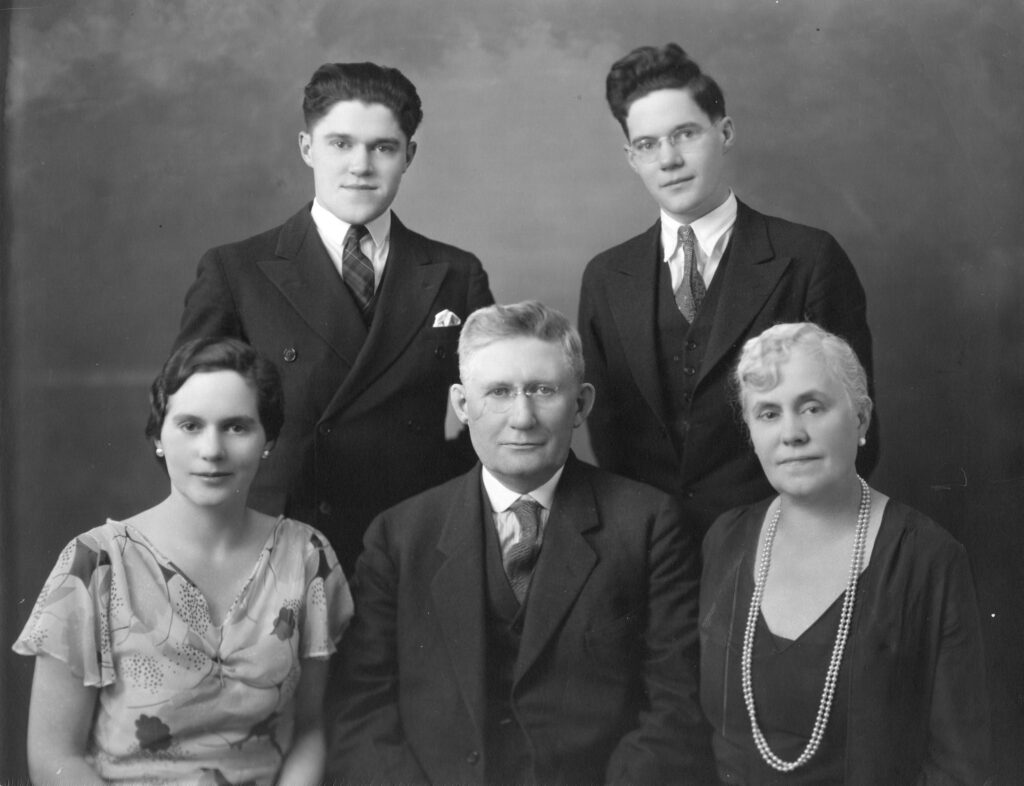My father’s mother was born in rural Ontario and grew up on a farm on the Manitoba prairie, but that doesn’t mean she wanted to live on a farm all her life. In fact, she had other plans.
There were basically two career paths open to women in the early 20th century: teaching and nursing. She pursued both. Then, when she married a Winnipeg physician, her future in the city was assured.
Lillian May Forrester (1880-1956) was the daughter of John Macfarlane Forrester (known as Jack) and his wife, Samantha Rixon (known as Mattie).1 Lillian’s twin brother, Arthur, died the day of their birth, but, according to a family story, Lillian was placed in a box behind the woodstove to keep warm, and she survived.

The Forrester farm was located in Tyendinaga, near Belleville, Ontario. The property was quite small and the Forresters were a large and expanding family. They needed more land. Good farmland was becoming scarce and expensive in Ontario, while Manitoba, which had recently been opened up to settlement, looked very attractive.
In 1881, the Forresters bought land near Emerson, close to the American border and the Red River. Lillian’s parents farmed one property, her uncle William farmed the property across the road and her grandparents, James and Janet Forrester, farmed an adjoining half section with their son Donald. Lillian grew up with her five younger brothers and sisters and many cousins. According to Lillian, the Forresters “loved” their new home on the prairie.2
There was always work to do and, as the eldest of the children, Lillian must have had to do chores, such as helping to care for the animals. She had a bossy personality (years later she was nicknamed The Duchess), so she probably told the younger children what to do.
In a memoir,Lillian’s cousin Charles Reid Forrester wrote that the Forresters had their share of hardships. One year the crops were flattened by a hailstorm, and another time, lightning struck Grandpa Forrester’s stable, killing two horses, a cow and a sheep. 3 Lillian may also have remembered her grandmother’s flower garden, her mother’s freshly baked bread, and festive family parties when everyone danced to the music of the piano, violin and mouth organ and her father sang his favourite Scottish ballads.
She was exposed to many books and ideas at home. Cousin Charlie described Jack Forrester as very intelligent and a student of American and Scottish history, 4 while Lillian later wrote that she owed a special debt to her grandmother, who was an avid reader and a poet.5

Lillian attended the Des Marais school, a one-room schoolhouse that served the area. After graduating, she became a teacher herself,6 but she must have decided that teaching was not the right career for her.
By the early 1900s, nursing had become a modern, well-organized profession, with nursing schools open across Canada.7Perhaps Lillian thought there was a need for better medical care in rural communities, or maybe she saw this as an opportunity to move to the city. Whatever her motivation, she applied to the Winnipeg General Hospital School of Nursing.
She was 25 years old when she graduated, however, she did not work as a nurse for long. A year later, she married Dr. Thomas Glendenning (T.G.) Hamilton. T.G. practised medicine, surgery and obstetrics just across the river from the expanding city of Winnipeg.
The wedding took place in November, 1906 at Lillian’s uncle’s Winnipeg home. Three years later, the first of the couple’s four children was born and in 1910, the Hamiltons’ newly built three-storey house in suburban Elmwood was ready for them. It was Lillian’s home for the rest of her life.
This article is also posted on https://genealogyensemble.com
See also:
Janice Hamilton, “Exploring Emerson,” Writing Up the Ancestors, Feb. 14, 2014, https://www.writinguptheancestors.ca/2014/02/exploring-emerson.html
Janice Hamilton “James and Janet Forrester,” Writing Up the Ancestors, Feb. 5, 2014, https://www.writinguptheancestors.ca/2014/02/james-and-janet.html
Janice Hamilton, “Mattie Rixon and the Forrester Family,” Writing up the Ancestors, June 8, 2015, https://www.writinguptheancestors.ca/2015/06/mattie-rixon-and-forrester-family.html
Sources:
- “Ontario Births, 1869-1912,” database with images, FamilySearch (https://familysearch.org/ark:/61903/3:1:9Q97-Y3SZ-37X?cc=1784212&wc=QZ3B-GHJ%3A1584203503%2C1584203606%2C1584213601: 15 January 2016), Births > 1880 > no 7692-15395 > image 349 of 801; citing Archives of Ontario, Toronto.
- Lillian Forrester Hamilton, “Our Ancestors,” photocopy of a four-page typed document, in my possession.
- Charles R. Forrester, My World in Story, Verse and Song, self-published, Altona, Manitoba, 1979. p 29
- Charles Forrester, Ibid, p 109-110
- Lillian Hamilton, Ibid.
- 1901 census of Canada, Montcalm, Provencher, Manitoba, population schedule, page 3, family no. 25, Lillian Forester; digital image, Ancestry.ca (http://ancestry.ca, accessed 26 Nov. 2009); citing Library and Archives Canada, Census of Canada, 1901, Ottawa, Canada: Library and Archives Canada, RG31,T-6428 to T-6556.
- Anonymous. Wikipedia “History of Nursing” https://en.m.wikipedia.org/wiki/History_of_nursing, accessed Dec. 10, 2018

